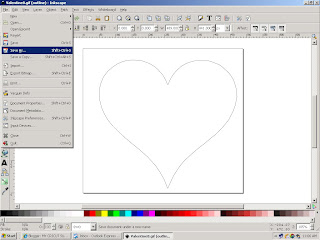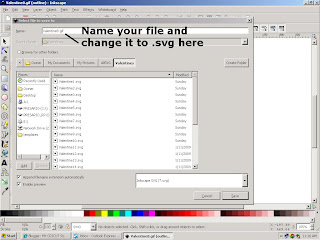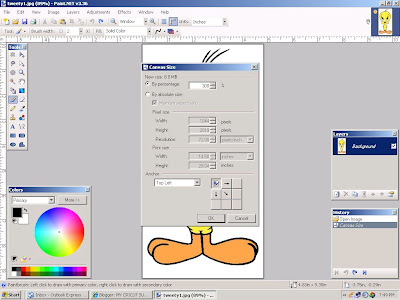
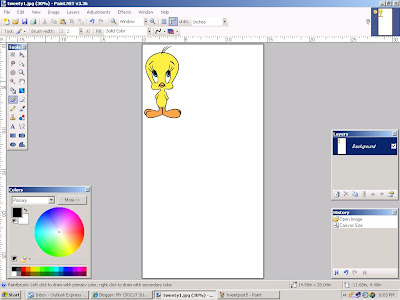
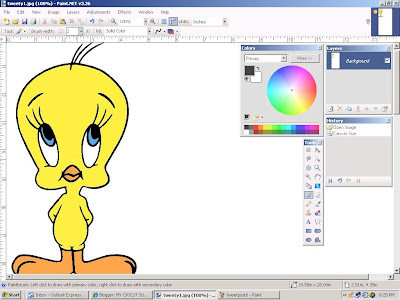 NOW for the 'FUN' part. First we'll take the yellow part of Tweety and set it aside. There is only one yellow area in this image so it's easy to break it out. Using the 'Magic Wand' tool, click it anywhere in the yellow area. The yellow part is now selected. Using the 'Move Selected Pixels' tool, click and hold on the highlighted yellow area and drag it downward until it is clear of the remaining image.
NOW for the 'FUN' part. First we'll take the yellow part of Tweety and set it aside. There is only one yellow area in this image so it's easy to break it out. Using the 'Magic Wand' tool, click it anywhere in the yellow area. The yellow part is now selected. Using the 'Move Selected Pixels' tool, click and hold on the highlighted yellow area and drag it downward until it is clear of the remaining image.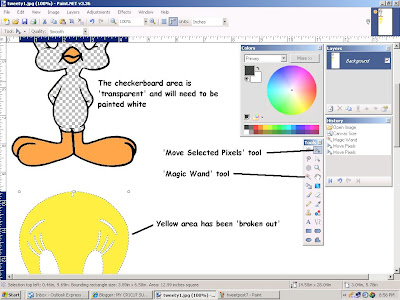
You'll notice that where the yellow used to be, there is a checkerboard pattern. This area is transparent as far as the computer is concerned, and Inkscape doesn't handle transparent well, so we'll have to make it white. Using the 'Magic Wand', click on the transparent area to select it, then using the 'Paint Can' flood tool color it white. When you zoom out you'll have a white Tweety with the yellow part below like this:
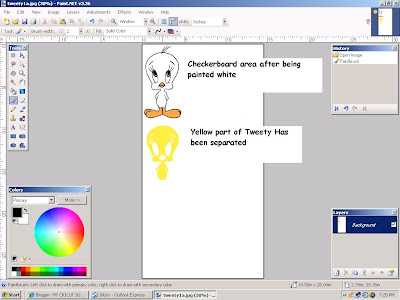
Now zoom back in so we can separate the orange parts - Tweety's feet and beak. Using the 'Magic Wand' tool, and while holding the 'Crtl' key, click on each of the 4 orange areas to highlight all of them at once. This will create another layer consisting of the orange areas only. *Remember* that you can drag the toolboxes out of the way. The image should now look like this:
 Click the 'Move Selected Pixels' tool. An area will be 'boxed in' that includes all of the orange areas that were selected in the last step. Click and hold anywhere inside the box, and drag it to an open area on the work area. You may have to zoom out to make it easier to position the orange layer on your canvas.
Click the 'Move Selected Pixels' tool. An area will be 'boxed in' that includes all of the orange areas that were selected in the last step. Click and hold anywhere inside the box, and drag it to an open area on the work area. You may have to zoom out to make it easier to position the orange layer on your canvas.
 Select and paint the transparent areas white as we we did before. Now you can use the same technique to separate the blue and finally the black areas. Don't forget to paint the transparent areas as they are created. *HINT* You can use one of the 3 'Select' tools to re-arrange the layers to make the best use of your work area. You should now have an image thet looks something like this:
Select and paint the transparent areas white as we we did before. Now you can use the same technique to separate the blue and finally the black areas. Don't forget to paint the transparent areas as they are created. *HINT* You can use one of the 3 'Select' tools to re-arrange the layers to make the best use of your work area. You should now have an image thet looks something like this:
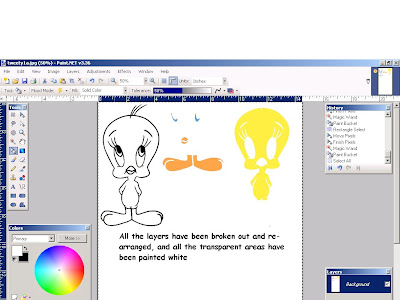
One more step and your image is ready to be converted to SVG in Inkscape. Use the 'Rectangle Select' tool to select all the layers together. Click 'Image' on the toolbar then click 'Crop to Selection'. The finished image will look like this:
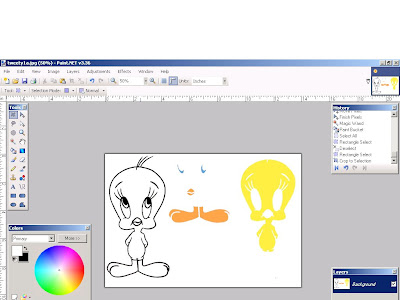 Save your work and it is ready for conversion to SVG in Inkscape. If you have gotten this far with me you are probably familiar with Inkscape and will know how to manipulate the image and its layers, but I think I'll do the next post on converting this image for those of you that aren't quite sure of what to do next. Stay tuned! Until then.......
Save your work and it is ready for conversion to SVG in Inkscape. If you have gotten this far with me you are probably familiar with Inkscape and will know how to manipulate the image and its layers, but I think I'll do the next post on converting this image for those of you that aren't quite sure of what to do next. Stay tuned! Until then.......

 Your 'de-mottled' image (at actual size) should look like this:
Your 'de-mottled' image (at actual size) should look like this: 
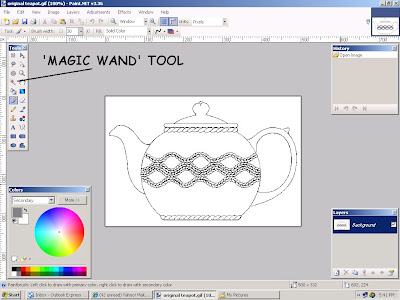 In the 'Tools' box on the left select the 'magic wand'. It looks like a little torch. Click the'+' part of the wand cursor on the spout area of the teapot. Notice the sparkly line that appears around the spout area. This means that everything inside the sparkly line is selected and can be modified and everything else is ignored. Click the 'Paint Bucket' cursor with black for the color inside the selected area.
In the 'Tools' box on the left select the 'magic wand'. It looks like a little torch. Click the'+' part of the wand cursor on the spout area of the teapot. Notice the sparkly line that appears around the spout area. This means that everything inside the sparkly line is selected and can be modified and everything else is ignored. Click the 'Paint Bucket' cursor with black for the color inside the selected area. 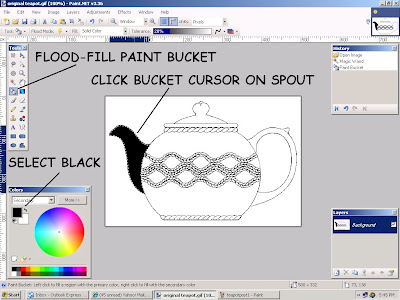 Use the wand and bucket to fill in the other large areas until your image looks like this:
Use the wand and bucket to fill in the other large areas until your image looks like this: 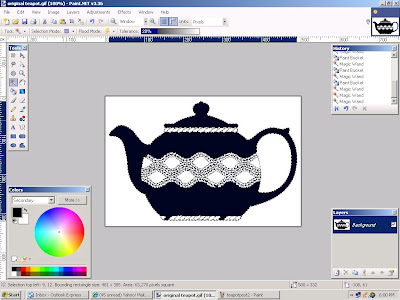 Next click the wand on the pattern area near the teapot handle. Notice that the area inside the handle is also selected. This is because the area we need to color isn't completely enclosed by the black outline. In this image, a couple of pixels are missing from the pattern outline. This isn't visible at this magnification level. Using the 'View' and 'Zoom in" feature, increase the magnification level to 300%.
Next click the wand on the pattern area near the teapot handle. Notice that the area inside the handle is also selected. This is because the area we need to color isn't completely enclosed by the black outline. In this image, a couple of pixels are missing from the pattern outline. This isn't visible at this magnification level. Using the 'View' and 'Zoom in" feature, increase the magnification level to 300%.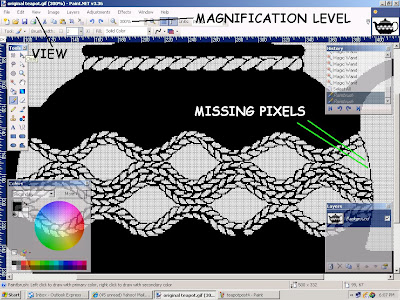 The gaps in the outline are now more easily seen. To replace them, use the paint brush with black as the color. Set the brush width to 1 or 2 pixels. Be sure to select the entire image using 'Edit' and 'Select all' from the drop down menu. Now just click on the image where the missing pixels should be.
The gaps in the outline are now more easily seen. To replace them, use the paint brush with black as the color. Set the brush width to 1 or 2 pixels. Be sure to select the entire image using 'Edit' and 'Select all' from the drop down menu. Now just click on the image where the missing pixels should be.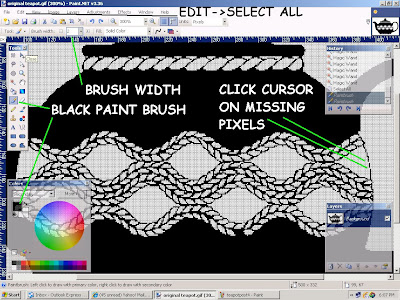 Now that the missing pixels are replaced, you can click the wand on the pattern area and fill it with black. While we are at this magnification you can paint in the little areas of the pattern until the outline of the teapot is more distinctly defined. You can move the various boxes out of the way by clicking and dragging on the blue bar at the top of the box. Next increase the brush width to about 20 and paint in the rest of the teapot except for the bottom. We have another technique to make painting that area easier.
Now that the missing pixels are replaced, you can click the wand on the pattern area and fill it with black. While we are at this magnification you can paint in the little areas of the pattern until the outline of the teapot is more distinctly defined. You can move the various boxes out of the way by clicking and dragging on the blue bar at the top of the box. Next increase the brush width to about 20 and paint in the rest of the teapot except for the bottom. We have another technique to make painting that area easier.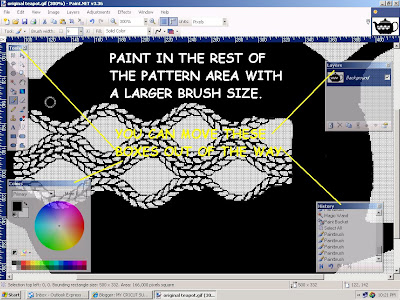
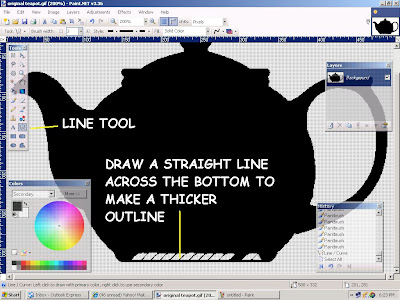 Finally, click 'View->Actual size' to return the image to its original size. Save your work and it is ready to be converted to SVG in Inkscape. The next post will be Kristina's Teacup.
Finally, click 'View->Actual size' to return the image to its original size. Save your work and it is ready to be converted to SVG in Inkscape. The next post will be Kristina's Teacup.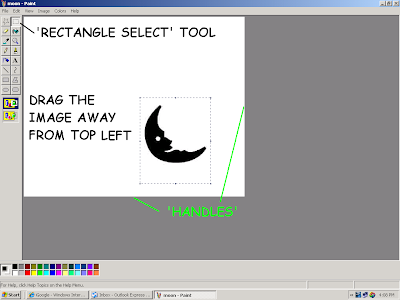
 A copy of your original image will appear in the top left of your work area. The duplicate will be selected. Next click 'Image>Flip/Rotate. In the box that appears be sure to select 'Flip horizontal', then click 'OK'.
A copy of your original image will appear in the top left of your work area. The duplicate will be selected. Next click 'Image>Flip/Rotate. In the box that appears be sure to select 'Flip horizontal', then click 'OK'. The copied image is now mirrored. Next select the original image, making sure that 'Transparent' mode is active, and drag it towards the mirrored image. Carefully line up the images so that they touch symmetrically at the hinge area. Because the images are touching they will be 'welded' when you convert to SVG.
The copied image is now mirrored. Next select the original image, making sure that 'Transparent' mode is active, and drag it towards the mirrored image. Carefully line up the images so that they touch symmetrically at the hinge area. Because the images are touching they will be 'welded' when you convert to SVG. The resulting 'welded' image should appear something like this:
The resulting 'welded' image should appear something like this:


 With the image enlarged, you can use the 'Magic Wand' to select the centers of the letters and use the paint bucket (or brush) to change the black areas to white. If you use the brush, note that the brush size is enlarged the same as the image.
With the image enlarged, you can use the 'Magic Wand' to select the centers of the letters and use the paint bucket (or brush) to change the black areas to white. If you use the brush, note that the brush size is enlarged the same as the image.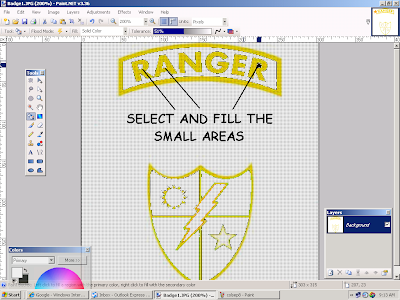
 You will find that even after the selecting and painting there are still some areas with poor detail. We must eliminate these so that you don't get a 'raggedy' SVG. To do this last step I use a technique that I call 'Pixel Painting'. Zoom in a couple of more steps until your image looks something like this:
You will find that even after the selecting and painting there are still some areas with poor detail. We must eliminate these so that you don't get a 'raggedy' SVG. To do this last step I use a technique that I call 'Pixel Painting'. Zoom in a couple of more steps until your image looks something like this:
 Now save your image so you can convert it in Inkscape.
Now save your image so you can convert it in Inkscape.  When you trace the bitmap in Inkscape select 'Brightness cutoff', set the threshold to about .650 - .700, and uncheck 'Smooth' (to give you sharper corners). Save your file and that's it! The gold part of the 'Badge' image is ready to cut. Now use the same techniques to make a silhouette of each of the remaining colors.
When you trace the bitmap in Inkscape select 'Brightness cutoff', set the threshold to about .650 - .700, and uncheck 'Smooth' (to give you sharper corners). Save your file and that's it! The gold part of the 'Badge' image is ready to cut. Now use the same techniques to make a silhouette of each of the remaining colors. The first thing we must do is to create a new folder in which to save our images.
The first thing we must do is to create a new folder in which to save our images. 

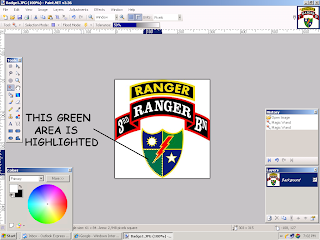
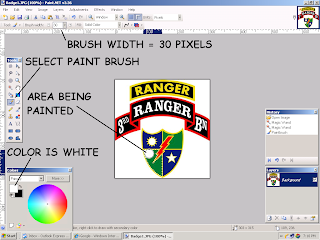

 Select the paint brush and white as your color, and a brush size that you are comfortable with.
Select the paint brush and white as your color, and a brush size that you are comfortable with.  You now should have an image that looks like this:
You now should have an image that looks like this: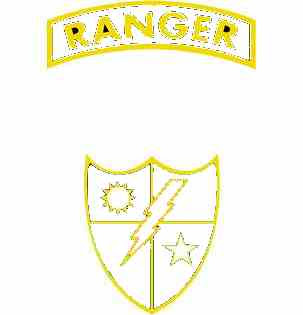 You should save the image at this point. Use the folder that you created earlier and use a file name that is easy to remember, like 'badgegold'. There are still some black areas and edge remnants but we will get rid of them and smoothen any jagged parts in the next post. If you have any questions -
You should save the image at this point. Use the folder that you created earlier and use a file name that is easy to remember, like 'badgegold'. There are still some black areas and edge remnants but we will get rid of them and smoothen any jagged parts in the next post. If you have any questions -


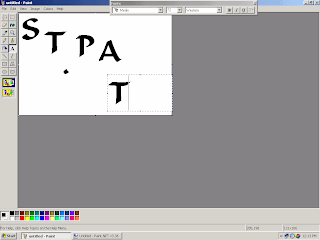
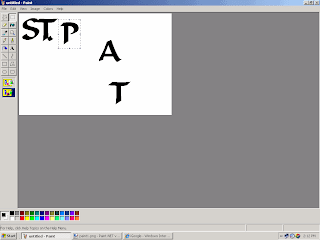
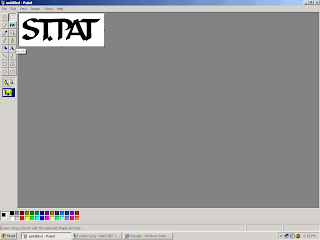
 Next, start INKSCAPE and click 'File' and 'Open' then select the image that you just saved. Now click on 'View'-Display Mode...- and click 'Outline...'. The image will be replaced with a red "X". Click on the border of the red "X" and it will be selected.
Next, start INKSCAPE and click 'File' and 'Open' then select the image that you just saved. Now click on 'View'-Display Mode...- and click 'Outline...'. The image will be replaced with a red "X". Click on the border of the red "X" and it will be selected.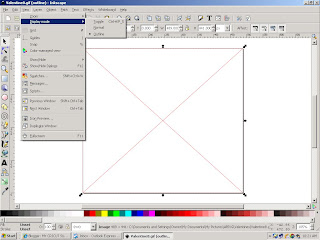 Now click on 'Path' then click 'Trace Bitmap...' and another window will appear. Make sure the red "X" is selected. In the new window, click on 'Brightness cutoff' and set the threshold value to about .650 then click 'Update'. Your image will appear the way it will look after cutting on your CRICUT. If you like the way it looks click OK. An outline of the image will appear in the red "X". The outline is the cut your CRICUT will make.
Now click on 'Path' then click 'Trace Bitmap...' and another window will appear. Make sure the red "X" is selected. In the new window, click on 'Brightness cutoff' and set the threshold value to about .650 then click 'Update'. Your image will appear the way it will look after cutting on your CRICUT. If you like the way it looks click OK. An outline of the image will appear in the red "X". The outline is the cut your CRICUT will make. Close the 'Trace Bitmap' window. The outline image will be selected but you will need to select the red "X". With the red "X" selected, hit the 'Delete' key on your keyboard and the red "X" will disappear. You are left with your finished SVG file. To save it, click on 'File' - Save As... and a new window will appear.
Close the 'Trace Bitmap' window. The outline image will be selected but you will need to select the red "X". With the red "X" selected, hit the 'Delete' key on your keyboard and the red "X" will disappear. You are left with your finished SVG file. To save it, click on 'File' - Save As... and a new window will appear.